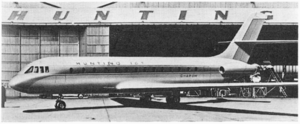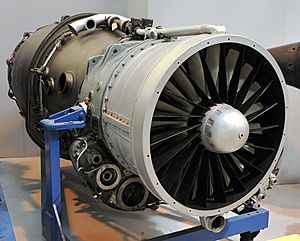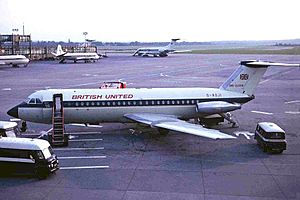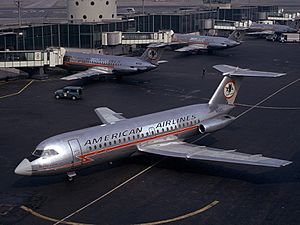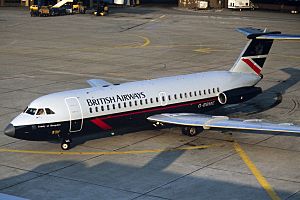BAC One-Eleven facts for kids
Quick facts for kids One-Eleven |
|
|---|---|
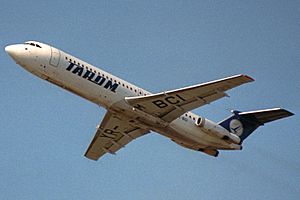 |
|
| A TAROM One-Eleven: a low wing airliner powered by two aft-mounted engines | |
| Role | Short-range jet airliner |
| National origin | United Kingdom |
| Manufacturer |
|
| First flight | 20 August 1963 |
| Introduction | 1965 with British United Airways |
| Retired | 7 May 2019 |
| Status | Retired |
| Primary users | British Airways
|
| Produced |
|
| Number built | 244 |
| Unit cost | 475/500: US$5.2M (1972) |
The BAC One-Eleven (also called BAC-111 or BAC 1-11) was an early jet airliner built by the British Aircraft Corporation (BAC). It was designed for shorter flights.
This plane was first thought of by Hunting Aircraft as a smaller 30-seat jet. After Hunting joined BAC in 1960, the design grew into an 80-seat airliner. The first order came from British United Airways on 9 May 1961.
The very first One-Eleven flew on 20 August 1963. It was delivered to its first customer on 22 January 1965. A longer version, the 500 series, which could carry 119 passengers, came out in 1967. In total, 244 One-Elevens were built in the United Kingdom until 1982. From 1982 to 1989, nine more planes, called Rombac One-Elevens, were built in Romania by Romaero under a special agreement.
This short haul, narrowbody aircraft had its engines placed at the back of the plane. These were Rolls-Royce Spey turbofan engines. This design was similar to other planes like the Sud Aviation Caravelle and later the Douglas DC-9.
The One-Eleven also competed with early versions of the Boeing 737. Many airlines in the US, UK, and Europe used it. Later, newer planes like the Airbus A320 and updated 737s replaced it. Rules about noise meant that by the 1990s, many One-Elevens were sold to airlines in Africa. The last BAC One-Eleven stopped flying in 2019.
Contents
How the One-Eleven Was Developed
Early Ideas for the Jet
In the 1950s, people really wanted to fly on jet planes. Many companies started designing passenger jets, even for short flights. In 1956, British European Airways asked for a "second generation" jet airliner. This led to many new designs from British aircraft makers. Hunting Aircraft began working on a jet to replace their popular Vickers Viscount. They called their 30-seat idea the Hunting 107.
In 1960, Hunting joined with other companies like Vickers-Armstrongs to form the British Aircraft Corporation (BAC). BAC thought the Hunting project was a good idea, but they believed a 30-seat jet was too small. So, they redesigned it into the BAC 107, which could hold 59 passengers.
After more research, BAC realized that even 59 seats were not enough. In 1961, they redesigned the plane again, making it an 80-seat aircraft. They also chose more powerful Rolls-Royce Spey engines. This new design was named the BAC 111, later known as the One-Eleven. Unlike some other British planes, the One-Eleven was made for airlines all over the world, not just for British companies. BAC hoped to sell as many as 400 of them.
On 9 May 1961, British United Airways (BUA) placed the first order for ten One-Eleven 200s. Soon after, airlines from the United States, Kuwait, and Ireland also ordered the plane. American Airlines ordered 15 aircraft in 1963, eventually buying 30 of the 400-series, becoming the biggest customer.
Testing the Prototypes
The first One-Eleven prototype (G-ASHG) was finished on 28 July 1963. It made its first flight on 20 August 1963. This was almost a year before its American rival, the Douglas DC-9, first flew. BAC felt the One-Eleven had a head start.
Sadly, the One-Eleven prototype crashed on 22 October 1963 during stall testing, and everyone on board was lost. The investigation helped discover a problem called deep stall. This happens when the wing blocks the airflow to the tail, making it hard for the pilot to control the plane. To fix this, BAC added special safety devices called stick shakers and stick pushers to the plane's controls. They also changed the wing's shape to improve airflow.
Even with the crash, testing continued, and airlines still trusted the plane. More orders came in from American Airlines, Braniff, and others. By the end of 1964, 13 planes were built. The first One-Eleven was given to BUA on 22 January 1965. It started flying passengers on 9 April from Gatwick to Genoa. By the end of 1965, 34 planes had been delivered to airlines.
The One-Eleven 500, 510ED, and 475
In 1967, a larger version called the One-Eleven 500 (or Super One-Eleven) was introduced. It could carry 119 passengers. This "stretched" version was delayed, which gave competing US planes like the Douglas DC-9 and Boeing 737 a chance to catch up. The 500 series did not sell well in the US. However, it was used by airlines in the Caribbean and Central America.
The One-Eleven 500 was about 13.5 feet (4.1 meters) longer than earlier versions. Its wings were also wider, and it used more powerful Spey 512 engines. This new version sold quite well around the world, especially to European charter airlines.
Some 500 series planes, called One-Eleven 510ED, were built for BEA/British Airways. These had a special cockpit with instruments similar to the Hawker Siddeley Trident. This made them easier for pilots who flew both types of planes. These changes were so big that pilots needed a different license to fly the 510ED compared to other One-Elevens.
By 1970, the One-Eleven also faced competition from smaller, newer planes like the Fokker F28 Fellowship. To compete, BAC launched the One-Eleven 475 in 1970. This version combined the smaller body of the 400 with the powerful engines and larger wing of the 500. It was designed for flying in hot places or from rough airfields, but only ten were sold.
Future Plans That Didn't Happen
After 1971, orders for the One-Eleven slowed down. British production continued until 1982, but only 35 more planes were delivered in 11 years. BAC hoped that Rolls-Royce would make a quieter and stronger engine for new One-Eleven versions. Also, Romania was talking about buying the whole One-Eleven project to build the planes there.
BAC worked on a One-Eleven 700 in 1974. It would have been longer, seating 134 passengers, with a new, quieter Spey engine. This would have been similar in size to the latest DC-9s and 737s. However, Rolls-Royce was having financial problems, and the new engine wasn't ready.
In 1975, BAC planned the One-Eleven 800, an even longer plane with new, powerful engines. This project was stopped in 1976. Instead, they worked on the X-Eleven, a wider version that could seat up to 166 passengers. In 1977, BAC joined with Hawker Siddeley to form British Aerospace (BAe). BAe decided to join other European companies to build a completely new plane, which became the Airbus A320. So, the X-Eleven was never built.
Building One-Elevens in Romania
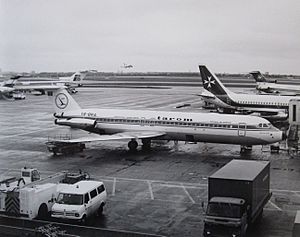
On 9 June 1979, the Romanian president signed a deal to build One-Elevens in Romania. This meant three complete planes would be sent from the UK, and at least 22 more would be built in Bucharest. Romanian companies would also make the Spey engines. These planes were called Rombac 1-11.
The first Rombac One-Eleven was finished on 27 August 1982 and flew on 18 September 1982. Production was much slower than planned. Only nine planes were delivered by 1989. The first one went to TAROM on 29 December 1982. Most went to TAROM, with two going to Romavia.
The Rombac project didn't work out well because Romania's economy struggled, making it hard to get parts. Also, the One-Eleven's noise levels and fuel use were not as good as newer planes from the US and Western Europe. After the Romanian Revolution, there were plans to restart production with new, quieter engines, but these deals also fell through.
How the One-Eleven Was Used
Once it started flying, the One-Eleven competed with the Douglas DC-9 and later the Boeing 737. The One-Eleven was cheaper than the DC-9.
Mohawk Airlines was the first American airline to use the One-Eleven for short flights. By the end of the 1960s, Mohawk had 20 One-Elevens. American Airlines and Braniff International Airways also ordered the plane. Aloha Airlines chose the One-Eleven for flights between the Hawaiian Islands.
Many British airlines, like Dan Air and British Caledonian, used the One-Eleven a lot. Dan Air even replaced all its older planes with One-Elevens in the 1980s. These planes helped Dan Air make a lot of money. Sometimes, Dan Air would rent its One-Elevens to other airlines.
Before British Airways (BA) was formed, some of its older companies, like British European Airways, used the One-Eleven. BA inherited these planes and found them very good. BA's 400-Series One-Elevens were named after places in the English Midlands. BA ordered more 500-Series planes in the late 1970s.
British Caledonian started replacing its One-Elevens with the new Airbus A320. When British Caledonian merged with British Airways in 1987, BA decided to use fewer types of planes. The One-Eleven was slowly replaced by the A320 and Boeing 737. The last One-Eleven stopped regular service with BA in October 1992.
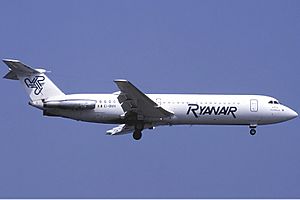
In Ireland, Aer Lingus flew One-Elevens for 30 years. The plane was also important for the early days of budget airline Ryanair. Ryanair started flying One-Elevens on its Dublin–Luton route in 1986. By 1988, Ryanair had six One-Elevens. Eventually, Ryanair replaced them with Boeing 737s in the mid-1990s.
In April 1966, Philippine Airlines began using One-Elevens. They had 12 of the later 500-Series. One of these planes had two serious incidents with explosions while flying, but it was repaired both times and kept flying until 1992. In another event in 1982, someone tried to take control of a Philippine One-Eleven on the ground, but the crew stopped him. No one was hurt. Philippine Airlines replaced the type with the Boeing 737 starting in 1989.
Romania was a big customer for British-made One-Elevens. In 1977, a deal was signed to transfer One-Eleven technology to Romania. This led to the planes being built there under the Rombac name. Rombac One-Elevens were used by airlines in Eastern and Western Europe, and by new airlines around the world, like Lauda Air in Austria. Two Rombac planes were even used as private jets for Romanian leaders.
One-Elevens were still widely used in Europe in the 1990s. When big airlines stopped using them, they were often sold to smaller airlines, especially in Asia and Africa. Nigeria used many One-Elevens until a crash in 2002 led to them being grounded. A big reason for the One-Eleven leaving European service was new noise regulations in 2003. Making the engines quieter was expensive, so many airlines decided to stop using the plane. In 2010, the European Aviation Safety Agency decided that One-Elevens registered in EU countries could no longer get a normal flying certificate. The last One-Eleven in the UK, used by the military, was retired in 2012. Finally, on 7 May 2019, the very last flyable One-Eleven, used by Northrop Grumman for testing, was retired.
Variants
- One-Eleven 200
- The first version built. It had Spey Mk 506 engines. 56 were made.
- One-Eleven 217
- A version for the Royal Australian Air Force (RAAF). It had a 200 series body, different engines, special tires, and a navigator's station. Two were built.
- One-Eleven 300
- Had stronger engines (Spey Mk 511s) and could carry more fuel for longer flights. Nine were built.
- One-Eleven 400
- Similar to the 300 series but with American instruments for sales in the US. 69 were built.
- One-Eleven 475
- Combined the body of the 400 with the larger wing and powerful engines of the 500. It also had stronger landing gear for rough airfields. Six were built.
- One-Eleven 485GD
- Similar to the 475, with three made for Oman.
- Rombac 1-11-495
- A planned Romanian-built version of the 475 series, but none were finished.
- One-Eleven 500
- A longer version with up to 119 seats and wider wings. It used more powerful Spey 512 engines. 86 were built.
- One-Eleven 510ED
- A special version of the 500 series for BEA/British Airways. Its cockpit was changed to be more like the Hawker Siddeley Trident.
- Rombac 1-11-560
- The Romanian-built version of the 500 series. Nine were completed.
- One-Eleven 670
- A 475 series plane with better aerodynamics and less noise. Only one was converted.
Operators
The BAC One-Eleven was used by many airlines and military groups.
After its main flying certificate was taken away, some One-Elevens were still flown as experimental aircraft for research.
On 6 May 2019, the very last One-Eleven still flying was retired. It had been used by Northrop Grumman to test parts for the F-35 fighter jet.
Aircraft on Display
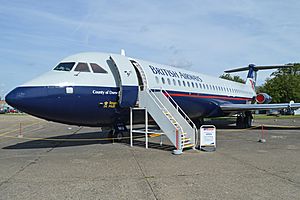
- One-Eleven 475AM G-ASYD is at the Brooklands Museum, Surrey, United Kingdom.
- One-Eleven 510ED G-AVMU is at the Imperial War Museum Duxford, Cambridgeshire, United Kingdom.
- One-Eleven 510ED G-AVMO is at the National Museum of Flight, East Fortune, Scotland, United Kingdom.
- One-Elevens CC-CYL and CC-CYM are at the Museo Nacional Aeronáutico y del Espacio in Santiago, Chile.
- One-Eleven 510ED G-AVMN is at the Panzemuseum East, Slagelse, Denmark. It used to belong to AB Airlines.
- A former US Air BAC One-Eleven, N1117J, is near Orlando International Airport. It is used for firefighting practice.
- A former BAC One-Eleven 539GL, ZH763, is at the Cornwall Aviation Heritage Centre in Newquay, Cornwall.
- Two Rombac One-Eleven 560 (YR-BRE and YR-BRI) are stored at Bucharest Henri Coandă International Airport. These planes are considered important cultural heritage in Romania.
- BAC One-Eleven TZ-BSC, owned by Romaero, was restored and shown at the Bucharest International Air Show in 2018.
- A former Aero America BAC One-Eleven, N111RZ, is at the Indian Hills Equestrian Centre, Illinois. It is missing one wing.
Specifications
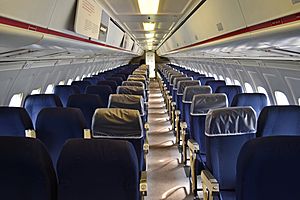
| Model | 200 | 300/400 | 475 | 500 |
|---|---|---|---|---|
| Cockpit crew | 2 | |||
| Seating limit | 89 | 119 | ||
| Length | 93 ft 6 in (28.50 m) | 107 ft 0 in (32.61 m) | ||
| Wing | 88 ft 6 in (26.97 m) span, 980 sq ft (91 m2) area | 93 ft 6 in (28.50 m) span, 1,031 sq ft (95.8 m2) area | ||
| Height | 24 ft 6 in (7.47 m) | |||
| Cabin Width | 10 ft 6 in (3.20 m) | |||
| Cabin length | 50 ft 0 in (15.24 m) | 56 ft 10 in (17.32 m) | 70 ft 4 in (21.44 m) | |
| Empty weight | 46,312 lb (21,007 kg) | 48,722 lb (22,100 kg) | 51,731 lb (23,465 kg) | 54,582 lb (24,758 kg) |
| MTOW | 78,500 lb (35,600 kg) | 87,000 lb (39,000 kg) | 98,500 lb (44,700 kg) | 104,500 lb (47,400 kg) |
| Max. payload | 17,688 lb (8,023 kg) | 22,278 lb (10,105 kg) | 21,269 lb (9,647 kg) | 26,418 lb (11,983 kg) |
| Engines | Rolls-Royce Spey Mk 506 | Mk 511 | Mk 512-14DW | |
| Thrust (x 2) | 10,410 lbf (46.3 kN) | 11,400 lbf (51 kN) | 12,550 lbf (55.8 kN) | |
| Max. cruise | 476 kn; 882 km/h | 470 kn; 871 km/h | ||
| Ceiling | 35,000 ft (11,000 m) | |||
| Climb rate | 2,750 ft/min (14.0 m/s) | 2,450 ft/min (12.4 m/s) | 2,480 ft/min (12.6 m/s) | 2,280 ft/min (11.6 m/s) |
| Takeoff (MTOW) | 6,250 ft (1,900 m) | 6,700 ft (2,000 m) | 5,500 ft (1,700 m) | 6,500 ft (2,000 m) |
| Range | 720 nmi; 1,340 km | 1,100 nmi; 2,040 km | 1,621 nmi; 3,001 km | 1,482 nmi; 2,744 km |
Images for kids
See also
 In Spanish: BAC 1-11 para niños
In Spanish: BAC 1-11 para niños
- Similar aircraft
- Boeing 737
- Dassault Mercure
- Fokker F28 Fellowship
- McDonnell Douglas DC-9
- Sud Aviation Caravelle
- Tupolev Tu-134
- Yakovlev Yak-42


